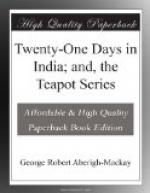In the cool of the evening our King emerges from the palace, and, riding on a prodigiously fat white horse with pink points, proceeds to the place of carousal. A long train of horsemen follow him, and footmen run before with guns in red flannel covers and silver maces, shouting “Raja Maharaja salaamat,” &c. The horsemen immediately around him are mounted on well-fed and richly-caparisoned steeds, with all the bravery of cloth-of-gold, yak-tails, silver chains, and strings of shells; behind are troopers in a burlesque of English uniform; and altogether in the rear is a mob of caitiffs on skeleton chargers, masquerading in every degree of shabbiness and rags, down to nakedness and a sword. The cavalcade passes through the city. The inhabitants pour out of every door and bend to the ground. Red cloths and white veils flutter at the casements overhead. You would hardly think that the spectacle was one daily enjoyed by the city. There is all the hurrying and eagerness of novelty and curiosity. Here and there a little shy crowd of women gather at a door and salute the Chief with a loud shrill verse of discordant song. It is some national song of the Chiefs ancestors and of the old heroic days. The place of carousal is a bare spot near a large and ancient well out of which grows a vast pipal tree. Hard by is a little temple surmounted by a red flag on a drooping bamboo. It is here that the Gangor[F] and Dassahra[F] solemnities are celebrated. Arrived on the ground, the Raja slowly circles his horse; then, jerking the thorn-bit, causes him to advance plunging and rearing, but dropping first on the near foot and then on the off foot with admirable precision; and finally, making the white monster, now in a lather of sweat, rise up and walk a few steps on his hind legs, the Raja’s performance concludes amid many shouts of wonder and delight from the smooth-tongued courtiers. The thakores and sardars now exhibit their skill in the manege until the shades of night fall, when torches are brought, amid much salaaming, and the cavalcade defiles, through the city, back to the palace. Lights are twinkling from the higher casements and reflected on the lake below; the gola[G] slave-girls are singing plaintive songs, drum and conch answer from the open courtyards. The palace is awake. The Raja, we will romantically presume, bounds lightly from his horse and dances gaily to the harem to fling himself voluptuously into the luxurious arms of one of the five-and-twenty queens, or one of the five-and-twenty grand duchesses; and they stand for one delirious moment wreathed in each other’s embraces—




